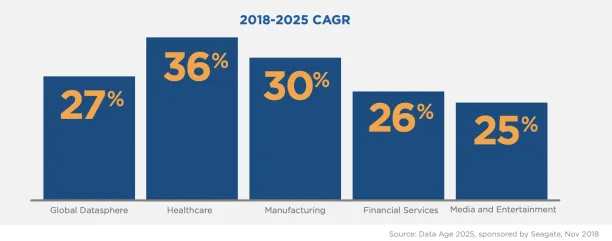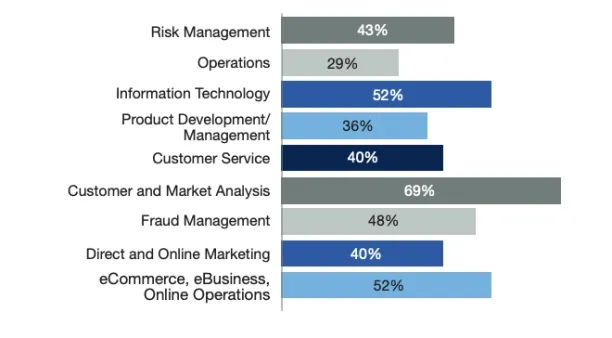The driving force behind big data is quantification of information. In the past, you would just go for a morning jog. Today, you know it was 7.6km long, you took 11,341 steps and burned 612 calories because of it.
While the growth in private data of companies is not visible, growth of data generation social media is quite visible. 300 hours of video show up on YouTube each minute.
We collected of 50 up-to-date big data statistics from surveys and reputable sources. In this list, you will find big data stats about:
Market size forecasts
Market size
- The big data analytics market was estimated to be worth $169 billion in 2018 and IDC expects worldwide big data analytics market revenue to be $274 billion by 2022. (International Data Cooperation)
- Big data analytics-related software revenues were worth $67 billion in 2019, with end-user query, reporting, and analysis tools ($14 billion) and relational data warehouse management tools ($12 billion) being the two largest software categories. (International Data Cooperation)
- In 2018, 38% of the global revenue from big data was from the services segment. (Statista)
- By 2027, software segment is expected to be the largest big data market segment with a share of 45%. (Statista)
Growth rate
- The big data analytics market is expected to grow with a five-year CAGR of 13%. (International Data Cooperation)
- Global big data market is expected to grow at a CAGR of 22% during the forecast period of 2017 to 2030. (Goldstein Research)
- Most growth is expected to be in the healthcare sector (36% CAGR) followed by the manufacturing (30% CAGR) and financial services (26% CAGR) between 2018-25. (Seagate)

Why does Big Data matter?
- In 2013 IBM claimed that 90% of the world’s data had been created in the previous 2 years alone, and we continue to double the rate of data production every 2 years. (IBM)
- Over 2.5 quintillion bytes of data was generated globally every day in 2017 and the total volume of data created worldwide is expected to reach 149 zettabytes by 2045. (Domo)
- IDC predicts that the Global Datasphere will grow from 45 Zettabytes (ZB) in 2019 to 175ZB by 2025. (IDC)
- The amount of global data sphere subject to data analysis will grow to 5 zettabytes by 2025. (IDC)
- It was estimated that 1.7MB of data will be created every second for every person on earth by 2020. (Domo)
- By 2020, there will be more than 2.9 million job postings for data science and analytics roles in the US alone. (PwC)
- Each minute in the world: (Domo)
- 500k tweets are shared on Twitter.
- YouTube users watch over 4 million videos.
- Netflix users stream 69k minutes of video.
- Snapchat users share 527k photos with each other.
- Over 100 million spam e-mails are sent .
- Google conducts 3.6 million searches.
- Users post 46k new posts on Instagram and 250k stories are shared.
- 15 million text messages are sent.
- Americans use 2.6 million GB of internet data.
Business Big Data adoption
Current adoption
- 90% of businesses currently say data and analytics are key to their organization’s digital transformation. (MicroStrategy)
- 36% of organizations rate big data as a critical function, 29% as very important, 20% as important, and 12% as somewhat important. (Dresner)
- In 2018, 60% of Dresner survey respondents claimed to use big data globally. (Dresner)
- In 2017, IBM was the largest big data and analytics vendor with $2.66 billion revenue. (International Data Cooperation)
- Companies spent about $187 billion on big data analytics in 2019. (International Data Cooperation)
- Banking (14%), discrete manufacturing (12%), process manufacturing (9%), professional services (8%), and government (7%) are the industries accounting for the greatest share of the big data and analytics revenues worldwide in 2018. (International Data Cooperation)
- Top 5 industries mentioned above make up nearly 50% of the global revenue generation. (International Data Cooperation)
- On average, companies analyze only 12% of the available data. (Leftronic)
Future adoption
- Between 2018 and 2022, as per data growth projections, the fastest growth is expected to come from retail (14% CAGR), followed by banking (13% CAGR) and professional services (13% CAGR). (International Data Cooperation)
- By 2022, 90% of corporate strategies will explicitly mention information as a critical enterprise asset and analytics as an essential competency. (Gartner)
Big Data Use cases
- Data warehouse optimization and forecasting were ranked top in big data use cases and marked important by more than 80% of the respondents in the Dresner Advisory Services survey. (Dresner)
- Customer/social analysis, predictive maintenance, fraud detection, clickstream analysis, and IoT followed and marked important by more than 70% of the respondents in the Dresner Advisory Services survey. (Dresner)
- According to NewVantage Partners survey, customer and market analysis (69%) is the first business function named when driving big data initiatives are considered followed by IT (52%) and Online Operations (52%). (NewVantage Partners)
- The other business functions named when driving big data initiatives are:

Big Data Benefits/Results of implementation
Financial benefits
- Netflix saves $1 billion a year in value from customer retention by using big data. (Inside Big Data)
- Companies experienced an increase in revenues by 8% and a decrease in costs by 10% by making use of biggest datatechnologies.
Benefits to other KPIs
- According to a McKinsey report, data-driven organizations are 23 times more likely to acquire customers and 6 times more likely to retain these customers. (McKinsey)
- Data-driven companies are 19 times more likely to be profitable. (McKinsey)
- By partnering with AWS, MicroStrategy has enabled its customers to quickly get started with their applications. “By optimizing our full analytics and mobility platform on AWS, we are enabling deployment, installation, and configuration with only 3 clicks instead of 400.” said Viyaj Anand, VP of MicroStrategy. (Amazon Web Services)
Qualitative benefits
- Companies reported several different benefits from their big data initiatives: better strategic decisions (69%), improved control of operational processes (54%), a better understanding of customers (52%), and cost reductions (47%). (Forbes)
- According to NewVantage Partners survey, seven basic groups of benefits are connected with big data initiatives. Fact-based decision making (22%) and improved customer experience (22%) are the most important benefits. (NewVantage Partners)
- The other benefits are: increased sales (15%), new product innovations (11%), reduced risk (11%), more efficient operations (10%) and higher quality products and services (10%) (NewVantage Partners)
Challenges of Big Data
One of the biggest data challenges is ensuring the quality and accessibility of information spread across disconnected systems. Here are some concrete examples:
- According to Mike Gualtieri, VP of Forrester Research, on average, between 60% and 73% of all data within an enterprise goes unused for analytics. (Forrester)
- Companies analyze only 12% of the available data. (Forrester)
- Only 22% of all data had the potential for analysis in 2012, with the figure expected to be 37% in 2020. (International Data Cooperation)
- In the HBR survey of approximately 700 business professionals, only 3% of the respondents said they were able to act on all of the customer data they collect, while 21% said they could act on very little of it. (Harvard Business Review)
Here is a list of our recommended articles related to big data and big data analytics, feel free to learn more:
- Data Marketplaces: What, Why, How, Types, Benefits, Vendors
- Data as a Service (DaaS): What, Why, How, Use cases & Tools
- First Party Data: What it is, Why it Matters, What it contains
- How do businesses democratize analytics with AI?
Also, don’t forget to check out our sortable and data-driven list of:
If you still have questions on big data and big data analytics, please don’t hesitate to contact us:
Sources:
Statista*, Statista**, Goldstein Research, International Data Cooperation, Seagate, IBM, Domo*, IDC, PwC, Domo**, MicroStrategy, Dresner, International Data Cooperation**, Gartner, NewVantage Partners, McKinsey, Forbes, Inside Big Data, Amazon Web Services, Forrester*, Forrester**, International Data Cooperation***, Harvard Business Review, Leftronic.
This article was originally written by former AIMultiple industry analyst Izgi Arda Ozsubasi and reviewed by Cem Dilmegani

Comments
Your email address will not be published. All fields are required.